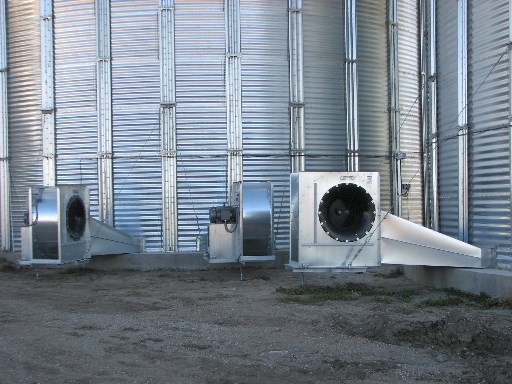Does natural-air corn drying really work?
Yes! Natural-air corn drying has been used successfully for many years by researchers at a number of agricultural experiment stations and by thousands of corn producers. The process works best under cool (40 to 60 degrees F), dry (55 to 75% relative humidity) conditions. Since average fall temperature and humidity are in these ranges in the Upper Midwest, natural-air drying usually works quite well.
Natural-air drying, also called ambient-air drying, near-ambient drying, unheated-air drying, or just air drying, is an in-storage drying method that uses unheated, outdoor air to dry corn to a safe storage moisture (13 to 15%). Instead of using heat energy from fossil fuels to remove moisture, natural-air drying uses electricity to operate fans, with energy for removing moisture coming primarily from the drying potential of outdoor air. Natural-air drying of shelled corn is similar in principle to the drying that takes place in cribs of ear corn, except that, because the airflow resistance for shelled corn is greater than for ear corn, fans rather than wind pressure move air through the bin.
Natural-air drying is basically a race between drying progress and growth of the fungi (commonly called molds) that cause grain spoilage. The bin is usually filled in a few days and the fan is started as soon as bin filling begins. Drying takes place in a one- to two-foot thick drying zone (also called a drying front) that moves slowly up through the bin (Figure 1). Grain below the zone is generally dry enough to be safe from spoilage, while grain above the zone remains at its initial moisture until the zone passes. (Note that positive pressure, or upward airflow, is recommended for natural-air drying so that wet grain is at the top of the bin. There it is easier to watch for signs of mold and to move moldy corn out of the bin if necessary.)
How long does drying take?
Drying time depends on initial grain moisture, airflow per bushel provided by the fan, and weather. If corn moistures and airflows recommended in Table 1 are used, drying usually takes four to eight weeks depending on the weather. In cool, damp falls, the drying zone doesn’t reach the top of the bin before winter and drying is completed in spring.
Table 1. Airflow and moisture recommendations for natural-air corn drying in the Upper Midwest.
Read more here http://www.extension.umn.edu/agriculture/corn/harvest/natural-air-corn-drying/


